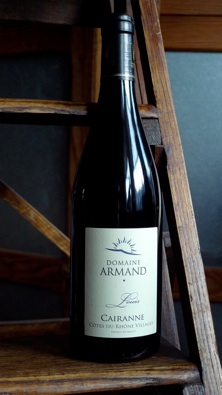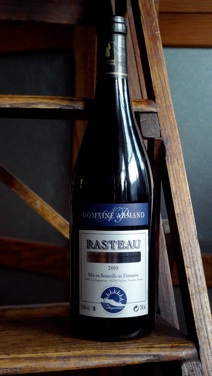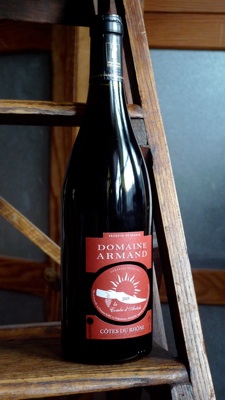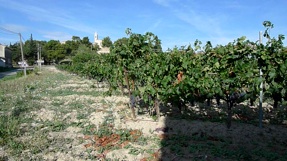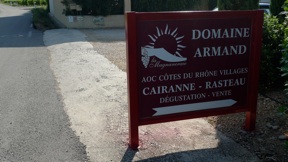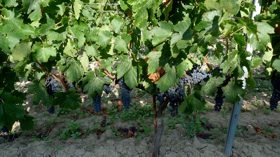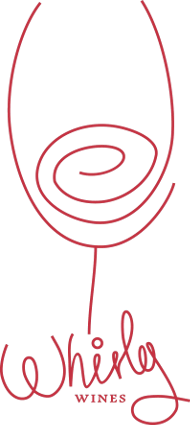On collecting my little Fiat 500 at Lyon airport I whizzed north to Macon and west ten kilometres to “ La Roche Vineuse” a little village just north of Pouilly and Fuisse ( these are separate villages, contrary to most thinking). As I searched for Alain and Sylvain Normand’s property I spotted a man on a little tractor and was about to ask for directions. It turns out to be Alain, with a big smile on his face we say “Bonjour “ and we meet back at the house.
Its bottling time and Alain is hands on with everything in the vineyard so he hands me over to his wife Sylvain. She happens to speak little English and I little French so what ensued was quite a comical yet successful little tour of the vineyards around the village that Alain owns and all in a little Peugeot 106 that covers the rocky terrain like a range rover and at a 20th of the price! What a wonderful vehicle: then again in Nigeria in the Eighties most of the taxis were battered Peugeot 504’s and they went on and on.
Alain has 33 hectares of vineyards altogether, divided between here, Pouilly Fuisse, Macon Village ( Salutre and Chaintre) and St Veran. Since 2009 he has been semi organic: farmed under the practices of “ Le Trei Lutte Raisonnee) and Terras Vitis, sustainable and common sense farming of the land with total control and hands on attention by Alain. Here in Macconias they are unique in being allowed to grow two grapes for their red wines; Gamay and Pinot Noir. The Pinot Noir grapes are the first vines I lay my eyes on with Sylvain and there is much grass evident in between the vines here; Alain wants to limit the amount of grapes so he keeps this grass growing during the whole summer. This increases the quality of the grapes too. Its a wonderful sight seeing the first sprouting leaves and some very tiny grapes appearing on the vines: the wonder of the green springing forth amidst a country of rocks, chalk and clay. Its quite the sight.
The Chardonnay grapes are pruned using the “ baguette” method, with a twisted semi circle and down onto the same piece of wire. The majority of grapes here in Macconais are Chardonnay. There is a lot of “Calcaire” dotted amongst the vines, big pieces of rock surround the edges too. It has not rained here at all in 2014, so this is a little worrying. The clay plays a big part in retaining the water when it falls so the vines can survive the hard months of the summer. The younger Pinot Noir vines that we come across later had the grass ploughed so that the energy is not take away from the infant plants. From the top of the hills here there was a fabulous view south to Beaujolais.
The top vineyard is called “ La Croix de Mortceau”. In the tasting room a few minutes later and after seeing Alain busy in the cellar getting the wines ready for bottling the next day ( Alain is totally hands on and in control of all parts of the winemaking clearly) we sat down and tasted some wines. First up was the Pouilly Fuisse 2011 in steel and very serious it was too; lean, clean, subtle fruit and long mineral tones with some real freshness too. My kind of wine. My kind of Chardonnay. The wine is from a new vineyard to Alain, in 2010 he acquired from Sylvain’s parents. Old vines though. So new but old, which is great.
We also tasted his 2010 Pouilly Fuisse in oak Barique. Sensational. It was during this conversation and tasting that Alain explained to me that history of the Premier Cru status. It started during the occupation of France by Germany during the 2nd world war. They occupied burgundy but only as far south as Chalon: they requisitioned wines from the french winemakers, except for their “First Growths”, which they were allowed to keep. Hence the Premier Cru status started but not as fas south as Macon since the occupation of France had not come that far south. Alain explained to me that St Veran and Pouilly Fuisse were soon hoping to get their Premier Cru status.
Lastly we tasted Alain’s Gamay from La Roche Vineuse, to me his signature wine in many ways: Gamay from Macon is unique, and its also, as we were to find out, a little more austere and richer than its counterparts a little further south. Twenty years ago, Alain explained to me this wine was simply called “ Macon”. These vines are his original vines, his pride and joy. Now they are vines from his own appellation, the only winemaker in “La Roche Vineuse”. The wine is a joy to drink. Trust me, its what Gamay should be. From here Mr Whirly booted south to Carpentras to visit Campagne Bacchus, a small “Organic’” winery owned by Richard and Diane Bacchus.
I arrived just as the sun was hiding opposite Mount Ventoux and a special sight it was too. The little green buds dotted the brown vines and landscape of the Cote de Ventoux land. The wind was pretty fierce yet there is a calm about this place that is serene and beautiful. Diane cooked a simple yet lovely pasta and tomato dish and we tasted their wines. Their Matines 2011 made from 75 % Grenache and 25 % Cinsault, lovely strawberry nose like a Pinot Noir, harvested early and a very long maceration of eight weeks called a Souple where they have the malo and alc fermentation together. A wonderful trip indeed followed by a little cafe in the square of Beaume de Venise the next morning.

